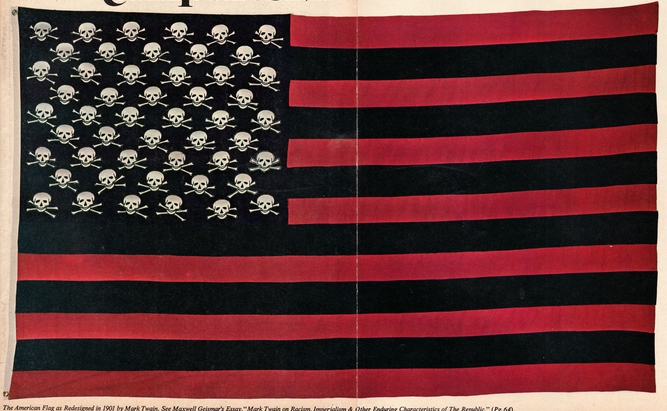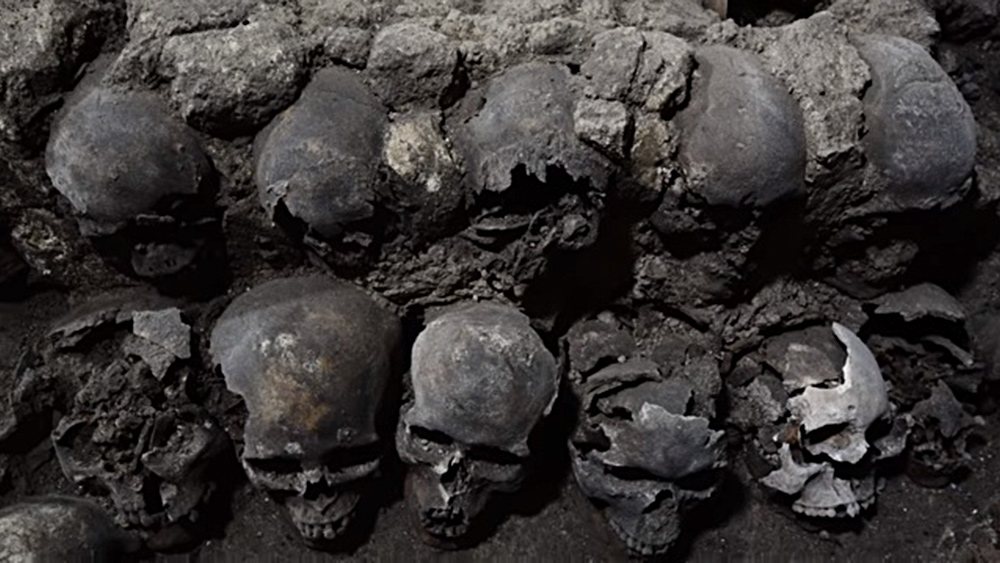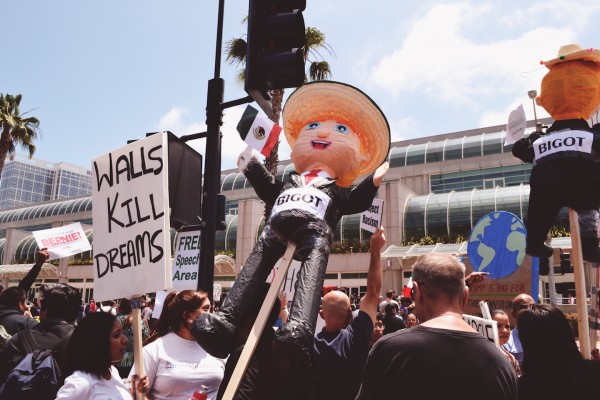“[America] goes not abroad in search of monsters to destroy…. She well knows that by once enlisting under other banners than her own, were they even the banners of foreign independence, she would involve herself, beyond the power of extrication, in all the wars of interest and intrigue, of individual avarice, envy, and ambition, which assume the colors and usurp the standard of freedom. The fundamental maxims of her policy would insensibly change from liberty to force. The frontlet upon her brows would no longer beam with the ineffable splendor of freedom and independence; but in its stead would soon be substituted an imperial diadem, flashing in false and tarnished lustre the murky radiance of dominion and power. She might become the dictatress of the world: she would be no longer the ruler of her own spirit.”[1]
– John Quincy Adams, July 4, 1821
“…we can have just our usual flag, with the white stripes painted black and the stars replaced with the skull and cross-bones.”[2]
– Mark Twain, regarding the U.S. conquest of the Philippines in 1899
The following list was compiled by the Congressional Research Service (CRS) and published under the title Instances of Use of United States Forces Abroad, 1798-2015. (It’s updated every few years.) Richard F. Grimmett, retired CRS specialist in International Security, was the original author of this report. The report has since been updated by the current author, Barbara Salazar Torreon, Analyst in Defense Budget and Military Manpower.[3]
As this list shows, the United States has invaded other countries hundreds of times. It’s interesting to note, however, that it has declared war only 11 times.
From the summary:
“Eleven times in its history, the United States has formally declared war against foreign nations. These 11 U.S. war declarations encompassed five separate wars: the war with Great Britain declared in 1812; the war with Mexico declared in 1846; the war with Spain declared in 1898; the First World War, during which the United States declared war with Germany and with Austria-Hungary during 1917; and World War II, during which the United States declared war against Japan, Germany, and Italy in 1941, and against Bulgaria, Hungary, and Rumania in 1942.”
Here’s a list of the invasions from 1950 to 1999, copied verbatim from the Congressional Research Service report, which is in the public domain. Remember, this is the U.S. government’s official version of history, so, naturally, every invasion is described as a benevolent venture to “protect American interests,” etc.
To see Part I of this series, click here.
1950-53
Korean War. The United States responded to North Korean invasion of South Korea by going to its assistance, pursuant to United Nations Security Council resolutions. U.S. forces deployed in Korea exceeded 300,000 during the last year of the conflict. Over 36,600 U.S. military were killed in action.
1950-55
Formosa (Taiwan). In June 1950 at the beginning of the Korean War, President Truman ordered the U.S. Seventh Fleet to prevent Chinese Communist attacks upon Formosa and Chinese Nationalist operations against Mainland China.
1954-55
China. Naval units evacuated U.S. civilians and military personnel from the Tachen Islands.
1956
Egypt. A marine battalion evacuated U.S. nationals and other persons from Alexandria during the Suez crisis.
1958
Lebanon. Marines were landed in Lebanon at the invitation of its government to help protect against threatened insurrection supported from the outside. The President’s action was supported by a Congressional resolution passed in 1957 that authorized such actions in that area of the world.
1959-60
The Caribbean. 2nd Marine Ground Task Force was deployed to protect U.S. nationals during the Cuban crisis.
1962
Thailand. The 3d Marine Expeditionary Unit landed on May 17, 1962 to support that country during the threat of Communist pressure from outside; by July 30, the 5,000 marines had been withdrawn.
1962
Cuba. On October 22, President Kennedy instituted a “quarantine” on the shipment of offensive missiles to Cuba from the Soviet Union. He also warned the Soviet Union that the launching of any missile from Cuba against any nation in the Western Hemisphere would bring about U.S. nuclear retaliation on the Soviet Union. A negotiated settlement was achieved in a few days.
1962-75
Laos. From October 1962 until 1975, the United States played an important role in military support of anti-Communist forces in Laos.
1964
Congo. The United States sent four transport planes to provide airlift for Congolese troops during a rebellion and to transport Belgian paratroopers to rescue foreigners.
1964-73
Vietnam War. U.S. military advisers had been in South Vietnam for a decade, and their numbers had been increased as the military position of the Saigon government became weaker. After citing what he termed were attacks on U.S. destroyers in the Tonkin Gulf, President Johnson asked in August 1964 for a resolution expressing U.S. determination to support freedom and protect peace in Southeast Asia. Congress responded with the Tonkin Gulf Resolution, expressing support for “all necessary measures” the President might take to repel armed attack against U.S. forces and prevent further aggression. Following this resolution, and following a Communist attack on a U.S. installation in central Vietnam, the United States escalated its participation in the war to a peak of 543,000 military personnel by April 1969.
1965
Dominican Republic. The United States intervened to protect lives and property during a Dominican revolt and sent more troops as fears grew that the revolutionary forces were coming increasingly under Communist control.
1967
Congo. The United States sent three military transport aircraft with crews to provide the Congo central government with logistical support during a revolt.
1970
Cambodia. U.S. troops were ordered into Cambodia to clean out Communist sanctuaries from which Viet Cong and North Vietnamese attacked U.S. and South Vietnamese forces in Vietnam. The object of this attack, which lasted from April 30 to June 30, was to ensure the continuing safe withdrawal of American forces from South Vietnam and to assist the program of Vietnamization.
1974
Evacuation from Cyprus. United States naval forces evacuated U.S. civilians during hostilities between Turkish and Greek Cypriot forces.
1975
Evacuation from Vietnam. On April 3, 1975, President Ford reported U.S. naval vessels, helicopters, and marines had been sent to assist in evacuation of refugees and U.S. nationals from Vietnam.
1975
Evacuation from Cambodia. On April 12, 1975, President Ford reported that he had ordered U.S. military forces to proceed with the planned evacuation of U.S. citizens from Cambodia.
1975
South Vietnam. On April 30, 1975, President Ford reported that a force of 70 evacuation helicopters and 865 marines had evacuated about 1,400 U.S. citizens and 5,500 third country nationals and South Vietnamese from landing zones near the U.S. Embassy in Saigon and the Tan Son Nhut Airfield.
1975
Mayaguez incident. On May 15, 1975, President Ford reported he had ordered military forces to retake the SS Mayaguez, a merchant vessel en route from Hong Kong to Thailand with a U.S. citizen crew which was seized by Cambodian naval patrol boats in international waters and forced to proceed to a nearby island.
1976
Lebanon. On July 22 and 23, 1974, helicopters from five U.S. naval vessels evacuated approximately250 Americans and Europeans from Lebanon during fighting between Lebanese factions after an overland convoy evacuation had been blocked by hostilities.
1976
Korea. Additional forces were sent to Korea after two American soldiers were killed by North Korean soldiers in the demilitarized zone between North and South Korea while cutting down a tree.
1978
Zaire. From May 19 through June 1978, the United States utilized military transport aircraft to provide logistical support to Belgian and French rescue operations in Zaire.
1980
Iran. On April 26, 1980, President Carter reported the use of six U.S. transport planes and eight helicopters in an unsuccessful attempt to rescue American hostages being held in Iran.
1981
El Salvador. After a guerilla offensive against the government of El Salvador, additional U.S. military advisers were sent to El Salvador, bringing the total to approximately 55, to assist in training government forces in counterinsurgency.
1981
Libya. On August 19, 1981, U.S. planes based on the carrier U.S.S. Nimitz shot down two Libyan jets over the Gulf of Sidra after one of the Libyan jets had fired a heat-seeking missile. The United States periodically held freedom of navigation exercises in the Gulf of Sidra, claimed by Libya as territorial waters but considered international waters by the United States.
1982
Sinai. On March 19, 1982, President Reagan reported the deployment of military personnel and equipment to participate in the Multinational Force and Observers in the Sinai. Participation had been authorized by the Multinational Force and Observers Resolution, P.L. 97-132.
1982
Lebanon. On August 21, 1982, President Reagan reported the dispatch of 80 marines to serve in the multinational force to assist in the withdrawal of members of the Palestine Liberation force from Beirut. The Marines left September 20, 1982.
1982-1983
Lebanon. On September 29, 1982, President Reagan reported the deployment of 1200 marines to serve in a temporary multinational force to facilitate the restoration of Lebanese government sovereignty. On Sept. 29, 1983, Congress passed the Multinational Force in Lebanon Resolution (P.L. 98-119) authorizing the continued participation for eighteen months.
1983
Egypt. After a Libyan plane bombed a city in Sudan on March 18, 1983, and Sudan and Egypt appealed for assistance, the United States dispatched an AWACS electronic surveillance plane to Egypt.
1983-89
Honduras. In July 1983 the United States undertook a series of exercises in Honduras that some believed might lead to conflict with Nicaragua. On March 25, 1986, unarmed U.S. military helicopters and crewmen ferried Honduran troops to the Nicaraguan border to repel Nicaraguan troops.
1983
Chad. On August 8, 1983, President Reagan reported the deployment of two AWACS electronic surveillance planes and eight F-15 fighter planes and ground logistical support forces to assist Chad against Libyan and rebel forces.
1983
Grenada. On October 25, 1983, President Reagan reported a landing on Grenada by Marines and Army airborne troops to protect lives and assist in the restoration of law and order and at the request of five members of the Organization of Eastern Caribbean States.
1984
Persian Gulf. On June 5, 1984, Saudi Arabian jet fighter planes, aided by intelligence from a U.S. AWACS electronic surveillance aircraft and fueled by a U.S. KC-10 tanker, shot down two Iranian fighter planes over an area of the Persian Gulf proclaimed as a protected zone for shipping.
1985
Italy. On October 10, 1985, U.S. Navy pilots intercepted an Egyptian airliner and forced it to land in Sicily. The airliner was carrying the hijackers of the Italian cruise ship Achille Lauro who had killed an American citizen during the hijacking.
1986
Libya. On March 26, 1986, President Reagan reported to Congress that, on March 24 and 25, U.S. forces, while engaged in freedom of navigation exercises around the Gulf of Sidra, had been attacked by Libyan missiles and the United States had responded with missiles.
1986
Libya. On April 16, 1986, President Reagan reported that U.S. air and naval forces had conducted bombing strikes on terrorist facilities and military installations in Libya.
1986
Bolivia. U.S. Army personnel and aircraft assisted Bolivia in anti-drug operations.
1987-88
Persian Gulf. After the Iran-Iraq War resulted in several military incidents in the Persian Gulf, the United States increased U.S. joint military forces operations in the Persian Gulf and adopted a policy of reflagging and escorting Kuwaiti oil tankers through the Gulf. President Reagan reported that U.S. Navy ships had been fired upon or struck mines or taken other military action on September 23, October 10, and October 20, 1987 and April 19, July 4, and July 14, 1988. The United States gradually reduced its forces after a cease-fire between Iran and Iraq on August 20, 1988.
1988
Panama. In mid-March and April 1988, during a period of instability in Panama and as pressure grew for Panamanian military leader General Manuel Noriega to resign, the United States sent 1,000 troops to Panama, to “further safeguard the canal, U.S. lives, property and interests in the area.” The forces supplemented 10,000 U.S. military personnel already in Panama.
1989
Libya. On January4, 1989, two U.S. NavyF-14 aircraft based on the U.S.S. John F. Kennedy shot down two Libyan jet fighters over the Mediterranean Sea about 70 miles north of Libya. The U.S. pilots said the Libyan planes had demonstrated hostile intentions.
1989
Panama. On May 11, 1989, in response to General Noriega’s disregard of the results of the Panamanian election, President Bush ordered a brigade-sized force of approximately 1,900 troops to augment the estimated 11,000 U.S. forces already in the area.
1989
Andean Initiative in War on Drugs. On September 15, 1989, President Bush announced that military and law enforcement assistance would be sent to help the Andean nations of Colombia, Bolivia, and Peru combat illicit drug producers and traffickers. By mid-September there were 50-100 U.S. military advisers in Colombia in connection with transport and training in the use of military equipment, plus seven Special Forces teams of 2-12 persons to train troops in the three countries.
1989
Philippines. On December 2, 1989, President Bush reported that on December 1 U.S. fighter planes from Clark Air Base in the Philippines had assisted the Aquino government to repel a coup attempt. In addition, 100 marines were sent from the U.S. Navy base at Subic Bay to protect the U.S. Embassy in Manila.
1989-90
Panama. On December 21, 1989, President Bush reported that he had ordered U.S. military forces to Panama to protect the lives of American citizens and bring General Noriega to justice. By February 13, 1990, all the invasion forces had been withdrawn.
1990
Liberia. On August 6, 1990, President Bush reported that a reinforced rifle company had been sent to provide additional security to the U.S. Embassy in Monrovia, and that helicopter teams had evacuated U.S. citizens from Liberia.
1990
Saudi Arabia. On August 9, 1990, President Bush reported that he had ordered the forward deployment of substantial elements of the U.S. armed forces into the Persian Gulf region to help defend Saudi Arabia after the August 2 invasion of Kuwait by Iraq. On November 16, 1990, he reported the continued buildup of the forces to ensure an adequate offensive military option.
1991
Iraq. On January 18, 1991, President Bush reported that he had directed U.S. armed forces to commence combat operations on January 16 against Iraqi forces and military targets in Iraq and Kuwait, in conjunction with a coalition of allies and U.N. Security Council resolutions. On January 12 Congress had passed the Authorization for Use of Military Force against Iraq Resolution (P.L.102-1). Combat operations were suspended on February 28, 1991.
1991
Iraq. On May 17, 1991, President Bush stated in a status report to Congress that the Iraqi repression of the Kurdish people had necessitated a limited introduction of U.S. forces into northern Iraq for emergency relief purposes.
1991
Zaire. On September 25-27, 1991, after widespread looting and rioting broke out in Kinshasa, U.S. Air Force C-141s transported 100 Belgian troops and equipment into Kinshasa. U.S. planes also carried 300 French troops into the Central African Republic and hauled back American citizens and third country nationals from locations outside Zaire.
1992
Sierra Leone. On May 3, 1992, U.S. military planes evacuated Americans from Sierra Leone, where military leaders had overthrown the government.
1992
Kuwait. On August 3, 1992, the United States began a series of military exercises in Kuwait, following Iraqi refusal to recognize a new border drawn up by the United Nations and refusal to cooperate with U.N. inspection teams.
1992
Iraq. On September 16, 1992, President Bush stated in a status report to Congress that he had ordered U.S. participation in the enforcement of a prohibition against Iraqi flights in a specified zone in southern Iraq, and aerial reconnaissance to monitor Iraqi compliance with the cease-fire resolution.
1992
Somalia. On December 10, 1992, President Bush reported that he had deployed U.S. armed forces to Somalia in response to a humanitarian crisis and a U.N. Security Council Resolution determining that the situation constituted a threat to international peace. This operation, called Operation Restore Hope, was part of a U.S.-led United Nations Unified Task Force (UNITAF) and came to an end on May 4, 1993. U.S. forces continued to participate in the successor United Nations Operation in Somalia (UNOSOM II), which the U.N. Security Council authorized to assist Somalia in political reconciliation and restoration of peace.
1993
Iraq. On January19, 1993, President Bush said in a status report that on December 27, 1992, U.S. aircraft had shot down an Iraqi aircraft in the prohibited zone; on January 13 aircraft from the United States and coalition partners had attacked missile bases in southern Iraq; and further military actions had occurred on January 17 and 18. Administration officials said the United States was deploying a battalion task force to Kuwait to underline the continuing U.S. commitment to Kuwaiti independence.
1993
Iraq. On January 21, 1993, shortly after his inauguration, President Clinton said the United States would continue the Bush policy on Iraq, and U.S. aircraft fired at targets in Iraq after pilots sensed Iraqi radar or anti-aircraft fire directed at them.
1993
Bosnia. On February28, 1993, the United States began an airdrop of relief supplies aimed at Muslims surrounded by Serbian forces in Bosnia.
1993
Bosnia. On April 13, 1993, President Clinton reported U.S. forces were participating in a NATO air action to enforce a U.N. ban on all unauthorized military flights over Bosnia-Hercegovina.
1993
Iraq. In a status report on Iraq of May24, President Clinton said that on April 9 and April 18 U.S. planes had bombed or fired missiles at Iraqi anti-aircraft sites that had tracked U.S. aircraft.
1993
Somalia. On June 10, 1993, President Clinton reported that in response to attacks against U.N. forces in Somalia by a factional leader, the U.S. Quick Reaction Force in the area had participated in military action to quell the violence. On July 1 President Clinton reported further air and ground military operations on June 12 and June 17 aimed at neutralizing military capabilities that had impeded U.N. efforts to deliver humanitarian relief and promote national reconstruction, and additional instances occurred in the following months.
1993
Iraq. On June 28, 1993, President Clinton reported that on June 26 U.S. naval forces had launched missiles against the Iraqi Intelligence Service’s headquarters in Baghdad in response to an unsuccessful attempt to assassinate former President Bush in Kuwait in April 1993.
1993
Iraq. In a status report of July 22, 1993, President Clinton said on June 19 a U.S. aircraft had fired a missile at an Iraqi anti-aircraft site displaying hostile intent. U.S. planes also bombed an Iraqi missile battery on August 19, 1993.
1993
Macedonia. On July 9, 1993, President Clinton reported the deployment of 350 U.S. soldiers to the former Yugoslav Republic of Macedonia to participate in the U.N. Protection Force to help maintain stability in the area of former Yugoslavia.
1993
Haiti. On October 20, 1993, President Clinton reported that U.S. ships had begun to enforce a U.N. embargo against Haiti.
1994
Bosnia. On February 17, 1994, President Clinton reported that the United States had expanded its participation in United Nations and NATO efforts to reach a peaceful solution to the conflict in former Yugoslavia and that 60 U.S. aircraft were available for participation in the authorized NATO missions.
1994
Bosnia. On March 1, 1994, President Clinton reported that on February 28 U.S. planes patrolling the “no-fly zone” in former Yugoslavia under the North Atlantic Treaty Organization (NATO) shot down 4 Serbian Galeb planes.
1994
Bosnia. On April 12, 1994, President Clinton reported that on April 10 and 11, U.S. warplanes under NATO command had fired against Bosnian Serb forces shelling the “safe” city of Gorazde.
1994
Rwanda. On April 12, 1994, President Clinton reported that combat-equipped U.S. military forces had been deployed to Burundi to conduct possible non-combatant evacuation operations of U.S. citizens and other third-country nationals from Rwanda, where widespread fighting had broken out. By September 30, 1994, all U.S. troops had departed from Rwanda and surrounding nations. In the Defense Appropriations Act for FY1995 (P.L. 103-335, signed September 30, 1994), Congress barred use of funds for U.S. military participation in or around Rwanda after October 7, 1994, except for any action necessary to protect U.S. citizens.
1994
Macedonia. On April 19, 1994, President Clinton reported that the U.S. contingent in the former Yugoslav Republic of Macedonia had been augmented by a reinforced company of 200 personnel.
1994
Haiti. On April 20, 1994, President Clinton reported that U.S. naval forces had continued enforcement of the U.N. embargo in the waters around Haiti and that 712 vessels had been boarded since October 20, 1993.
1994
Bosnia. On August 22, 1994, President Clinton reported the use on August 5 of U.S. aircraft under NATO to attack Bosnian Serb heavy weapons in the Sarajevo heavy weapons exclusion zone upon request of the U.N. Protection Forces.
1994
Haiti. On September 21, 1994, President Clinton reported the deployment of 1,500 troops to Haiti to restore democracy in Haiti. The troop level was subsequently increased to 20,000.
1994
Bosnia. On November 22, 1994, President Clinton reported the use of U.S. combat aircraft on November 21, 1994, under NATO, to attack bases used by Serbs to attack the town of Bihac in Bosnia.
1994
Macedonia. On December 22, 1994, President Clinton reported that the U.S. Army contingent in the former Yugoslav Republic of Macedonia continued its peacekeeping mission and that the current contingent would soon be replaced by about 500 soldiers from the 3rd Battalion, 5th Cavalry Regiment, 1st Armored Division from Kirchgons, Germany.
1995
Somalia. On March 1, 1995, President Clinton reported that on February 27, 1995, 1,800 combat-equipped U.S. armed forces personnel began deployment into Mogadishu, Somalia, to assist in the withdrawal of U.N. forces assigned there to the United Nations Operation in Somalia (UNOSOM II). This mission was completed on March 3, 1995.
1995
Haiti. On March 21, 1995, President Clinton reported that U.S. military forces in Haiti as part of a U.N. Multinational Force had been reduced to just under 5,300 personnel. He noted that as of March 31, 1995, approximately 2,500 U.S. personnel would remain in Haiti as part of the U.N. Mission in Haiti (UNMIH).
1995
Bosnia. On May 24, 1995, President Clinton reported that U.S. combat-equipped fighter aircraft and other aircraft continued to contribute to NATO’s enforcement of the “no fly zone” in airspace over Bosnia-Herzegovina. U.S. aircraft, he noted, were also available for close air support of U.N. forces in Croatia. Roughly 500 U.S. soldiers continued to be deployed in the former Yugoslav Republic of Macedonia as part of the U.N. Preventive Deployment Force (UNPREDEP). U.S. forces continued to support U.N. refugee and embargo operations in this region.
1995
Bosnia. On September 1, 1995, President Clinton reported that “U.S. combat and support aircraft” had been used beginning on August 29, 1995, in a series of NATO air strikes against Bosnian Serb Army (BSA) forces in Bosnia-Herzegovina that were threatening the U.N.-declared safe areas of Sarajevo, Tuzla, and Gorazde. He noted that during the first day of operations, “some 300 sorties were flown against 23 targets in the vicinity of Sarajevo, Tuzla, Gorazde and Mostar.”
1995
Haiti. On September 21, 1995, President Clinton reported that currently the United States had 2,400 military personnel in Haiti as participants in the U.N. Mission in Haiti (UNMIH). In addition, 260 U.S. military personnel were assigned to the U.S. Support Group Haiti.
1995
Bosnia. On December 6, 1995, President Clinton reported to Congress, that he had “ordered the deployment of approximately 1,500 U.S. military personnel” to Bosnia-Herzegovina and Croatia as part of a NATO “enabling force” to lay the groundwork for the prompt and safe deployment of the NATO-led Implementation Force (IFOR),” which would be used to implement the Bosnian peace agreement after its signing. The President also noted that he had authorized deployment of roughly 3,000 other U.S. military personnel to Hungary, Italy, and Croatia to establish infrastructure for the enabling force and the IFOR.
1995
Bosnia. On December 21, 1995, President Clinton reported to Congress that he had ordered the deployment of approximately 20,000 U.S. military personnel to participate in the NATO-led Implementation Force (IFOR) in the Republic of Bosnia-Herzegovina, and approximately 5,000 U.S. military personnel would be deployed in other former Yugoslav states, primarily in Croatia. In addition, about 7,000 U.S. support forces would be deployed to Hungary, Italy and Croatia and other regional states in support of IFOR’s mission.
1996
Haiti. On March 21, 1996, President Clinton reported to Congress that beginning in January 1996 there had been a “phased reduction” in the number of United States personnel assigned to the United Nations Mission in Haiti (UNMIH). As of March 21, 309 U.S. personnel remained a part of UNMIH. These U.S. forces were “equipped for combat.”
1996
Liberia. On April 11, 1996, President Clinton reported to Congress that on April 9, 1996 due to the “deterioration of the security situation and the resulting threat to American citizens” in Liberia he had ordered U.S. military forces to evacuate from that country “private U.S. citizens and certain third-country nationals who had taken refuge in the U.S. Embassy compound….”
1996
Liberia. On May20, 1996, President Clinton reported to Congress the continued deployment of U.S. military forces in Liberia to evacuate both American citizens and other foreign personnel, and to respond to various isolated “attacks on the American Embassy complex” in Liberia. The President noted that the deployment of U.S. forces would continue until there was no longer any need for enhanced security at the Embassy and a requirement to maintain an evacuation capability in the country.
1996
Central African Republic. On May 23, 1996, President Clinton reported to Congress the deployment of U.S. military personnel to Bangui, Central African Republic, to conduct the evacuation from that country of “private U.S. citizens and certain U.S. Government employees,” and to provide “enhanced security for the American Embassy in Bangui.”
1996
Bosnia. On June 21, 1996, President Clinton reported to Congress that United States forces totaling about 17,000 remain deployed in Bosnia “under NATO operational command and control” as part of the NATO Implementation Force (IFOR). In addition, about 5,500 U.S. military personnel were deployed in Hungary, Italy and Croatia, and other regional states to provide “logistical and other support to IFOR.” The President noted that it was the intention that IFOR would complete the withdrawal of all troops in the weeks after December 20, 1996, on a schedule “set by NATO commanders consistent with the safety of troops and the logistical requirements for an orderly withdrawal.” He also noted that a U.S. Army contingent (of about 500 U.S. soldiers) remained in the Former Yugoslav Republic of Macedonia as part of the United Nations Preventive Deployment Force (UNPREDEP).
1996
Rwanda and Zaire. On December 2, 1996, President Clinton reported to Congress that to support the humanitarian efforts of the United Nations regarding refugees in Rwanda and the Great Lakes Region of Eastern Zaire, he had authorized the use of U.S. personnel and aircraft, including AC-130U planes to help in surveying the region in support of humanitarian operations, although fighting still was occurring in the area, and U.S. aircraft had been subject to fire when on flight duty.
1996
Bosnia. On December 20, 1996, President Clinton reported to Congress that he had authorized U.S. participation in an IFOR follow-on force in Bosnia, known as SFOR (Stabilization Force), under NATO command. The President said the U.S. forces contribution to SFOR was to be “about 8,500” personnel whose primary mission is to deter or prevent a resumption of hostilities or new threats to peace in Bosnia. SFOR’s duration in Bosnia is expected to be 18 months, with progressive reductions and eventual withdrawal.
1997
Albania. On March 15, 1997, President Clinton reported to Congress that on March 13, 1997, he had utilized U.S. military forces to evacuate certain U.S. Government employees and private U.S. citizens from Tirana, Albania, and to enhance security for the U.S. Embassy in that city.
1997
Congo and Gabon. On March 27, 1997, President Clinton reported to Congress that, on March 25, 1997, a standby evacuation force of U.S. military personnel had been deployed to Congo and Gabon to provide enhanced security for American private citizens, government employees, and selected third country nationals in Zaire, and to be available for any necessary evacuation operation.
1997
Sierra Leone. On May 30, 1997, President Clinton reported to Congress that on May29 and May 30, 1997, U.S. military personnel were deployed to Freetown, Sierra Leone, to prepare for and undertake the evacuation of certain U.S. government employees and private U.S. citizens.
1997
Bosnia. On June 20, 1997, President Clinton reported to Congress that U.S. Armed Forces continued to support peacekeeping operations in Bosnia and other states in the region in support of the NATO-led Stabilization Force (SFOR). He reported that currently most U.S. military personnel involved in SFOR were in Bosnia, near Tuzla, and about 2,800 U.S. troops were deployed in Hungary, Croatia, Italy and other regional states to provide logistics and other support to SFOR. A U.S. Army continent of about 500 also remained in the Former Yugoslav Republic of Macedonia as part of the U.N. Preventive Deployment Force (UNPREDEP).
1997
Cambodia. On July 11, 1997, President Clinton reported to Congress that in an effort to ensure the security of American citizens in Cambodia during a period of domestic conflict there, he had deployed a Task Force of about 550 U.S. military personnel to Utapao Air Base in Thailand. These personnel were to be available for possible emergency evacuation operations in Cambodia as deemed necessary.
1997
Bosnia. On December 19, 1997, President Clinton reported to Congress that he intended “in principle” to have the United States participate in a security presence in Bosnia when the NATO SFOR contingent withdrew in the summer of 1998.
1998
Guinea-Bissau. On June 12, 1998, President Clinton reported to Congress that, on June 10, 1998, in response to an army mutiny in Guinea-Bissau endangering the U.S. Embassy, U.S. government employees and citizens in that country, he had deployed a standby evacuation force of U.S. military personnel to Dakar, Senegal, to remove such individuals, as well as selected third country nationals, from the city of Bissau. The deployment continued until the necessary evacuations were completed.
1998
Bosnia. On June 19, 1998, President Clinton reported to Congress regarding activities in the last six months of combat-equipped U.S. forces in support of NATO’s SFOR in Bosnia and surrounding areas of former Yugoslavia.
1998
Kenya and Tanzania. On August10, 1998, President Clinton reported to Congress that he had deployed, on August 7, 1998, a Joint Task Force of U.S. military personnel to Nairobi, Kenya, to coordinate the medical and disaster assistance related to the bombings of the U.S. Embassies in Kenya and Tanzania. He also reported that teams of 50-100 security personnel had arrived in Nairobi, Kenya, and Dar es Salaam, Tanzania, to enhance the security of the U.S. Embassies and citizens there.
1998
Albania. On August 18, 1998, President Clinton reported to Congress that he had, on August 16, 1998, deployed 200 U.S. Marines and 10 Navy SEALS to the U.S. Embassy compound in Tirana, Albania, to enhance security against reported threats against U.S. personnel.
1998
Afghanistan and Sudan. On August 21, 1998, by letter, President Clinton reported to Congress that he had authorized airstrikes on August 20th against camps and installations in Afghanistan and Sudan used by the Osama bin Laden terrorist organization. The President did so based on what he viewed as convincing information that the bin Laden organization was responsible for the bombings, on August 7, 1998, of the U.S. Embassies in Kenya and Tanzania.
1998
Liberia. On September 29, 1998, President Clinton reported to Congress that on September 27, 1998 he had, due to political instability and civil disorder in Liberia, deployed a stand-by response and evacuation force of 30 U.S. military personnel to augment the security force at the U.S. Embassy in Monrovia, and to provide for a rapid evacuation capability, as needed, to remove U.S. citizens and government personnel from the country.
1998
Iraq. During the period from December 16-23, 1998, the United States, together with the United Kingdom, conducted a bombing campaign, termed Operation Desert Fox, against Iraqi industrial facilities deemed capable of producing weapons of mass destruction, and against other Iraqi military and security targets.
1998-1999
Iraq. Beginning in late December 1998, and continuing during 1999, the United States, together with forces of the coalition enforcing the “no-fly” zones over Iraq, conducted military operations against the Iraqi air defense system on numerous occasions in response to actual or potential threats against aircraft enforcing the “no-fly” zones in northern and southern Iraq.
1999
Bosnia. On January 19, 1999, President Clinton reported to Congress that he was continuing to authorize the use of combat-equipped U.S. Armed Forces in Bosnia and other states in the region as participants in and supporters of the NATO-led Stabilization Force (SFOR). He noted that the U.S. SFOR military personnel totaled about 6,900, with about 2,300 U.S. military personnel deployed to Hungary, Croatia, Italy and other regional states. Also some 350 U.S. military personnel remain deployed in the Former Yugoslav Republic of Macedonia (FYROM) as part of the U.N. Preventive Deployment Force (UNPREDEP).
1999
Kenya. On February 25, 1999, President Clinton reported to Congress that he was continuing to deploy U.S. military personnel in that country to assist in providing security for the U.S. embassy and American citizens in Nairobi, pending completion of renovations of the American embassy facility in Nairobi, subject of a terrorist bombing in August 1998.
1999
Yugoslavia. On March 26, 1999, President Clinton reported to Congress that, on March 24, 1999, U.S. military forces, at his direction, and in coalition with NATO allies, had commenced air strikes against Yugoslavia in response to the Yugoslav government’s campaign of violence and repression against the ethnic Albanian population in Kosovo.
1999
Yugoslavia/Albania. On April 7, 1999, President Clinton reported to Congress, that he had ordered additional U.S. military forces to Albania, including rotary wing aircraft, artillery, and tactical missiles systems to enhance NATO’s ability to conduct effective air operations in Yugoslavia. About 2,500 soldiers and aviators are to be deployed as part of this task force. The President also reported the deployment of U.S. military forces to Albania and Macedonia to support humanitarian disaster relief operations for Kosovar refugees.
1999
Yugoslavia/Albania. On May25, 1999, President Clinton reported to Congress, “consistent with the war Powers Resolution” that he had directed “deployment of additional aircraft and forces to support NATO’s ongoing efforts [against Yugoslavia], including several thousand additional U.S. Armed Forces personnel to Albania in support of the deep strike force located there.” He also directed that additional U.S. forces be deployed to the region to assist in “humanitarian operations.”
1999
Yugoslavia/Kosovo. On June 12, 1999, President Clinton reported to Congress, “consistent with the War Powers Resolution” that he had directed the deployment of about “7,000 U.S. military personnel as the U.S. contribution to the approximately 50,000-member, NATO-led security force (KFOR)” currently being assembled in Kosovo. He also noted that about “1,500 U.S. military personnel, under separate U.S. command and control, will deploy to other countries in the region, as our national support element, in support of KFOR.”
1999
Bosnia. On July 19, 1999, President Clinton reported to Congress “consistent with the War Powers Resolution” that about 6,200 U.S. military personnel were continuing to participate in the NATO-led Stabilization Force (SFOR) in Bosnia, and that another 2,200 personnel were supporting SFOR operations from Hungary, Croatia, and Italy. He also noted that U.S. military personnel remain in the Former Yugoslav Republic of Macedonia to support the international security presence in Kosovo (KFOR).
1999
East Timor. On October 8, 1999, President Clinton reported to Congress “consistent with the War Powers Resolution” that he had directed the deployment of a limited number of U.S. military forces to East Timor to support the U.N. multinational force (INTERFET) aimed at restoring peace to East Timor. U.S. support has been limited initially to “communications, logistics, planning assistance and transportation.” The President further noted that he had authorized deployment of the amphibious ship USS BELLEAU WOOD, together with its helicopters and her complement of personnel from the 31st Marine Expeditionary Unit (Special Operations Capable) (MEU SOC) to the East Timor region, to provide helicopter airlift and search and rescue support to the multinational operation. U.S. participation was anticipated to continue until the transition to a U.N. peacekeeping operation was complete.
1999
Yugoslavia/Kosovo. On December 15, 1999, President Clinton reported to Congress “consistent with the War Powers Resolution” that U.S. combat-equipped military personnel continued to serve as part of the NATO-led security force in Kosovo (KFOR). He noted that the American contribution to KFOR in Kosovo was “approximately 8,500 U.S. military personnel.” U.S. forces were deployed in a sector centered around “Urosevac in the eastern portion of Kosovo.” For U.S. KFOR forces, “maintaining public security is a key task.” Other U.S. military personnel are deployed to other countries in the region to serve in administrative and logistics support roles for U.S. forces in KFOR. Of these forces, about 1,500 U.S. military personnel are in Macedonia and Greece, and occasionally in Albania.
1999-2000
Iraq. At various times during 1999, and continuing throughout 2000 the United States, together with forces of the coalition enforcing the “no-fly” zones over Iraq, conducted military operations against the Iraqi air defense system on numerous occasions in response to actual or potential threats against aircraft enforcing the “no-fly” zones in northern and southern Iraq.
Sources:
[1] TheAmericanConservative.com
[2] LoC.gov
[3] FAS.org



















